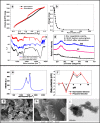Ceramic membrane-based ultrafiltration combined with adsorption by waste derived biochar for textile effluent treatment and management of spent biochar
- PMID: 33312617
- PMCID: PMC7721960
- DOI: 10.1007/s40201-020-00520-w
Ceramic membrane-based ultrafiltration combined with adsorption by waste derived biochar for textile effluent treatment and management of spent biochar
Abstract
Purpose: Effluents produced in the textile industries are important sources of water pollution due to the presence of toxic dyes, auxiliary chemicals, organic substances etc. Recycling of such industrial wastewater is one major aspect of sustainable water management; hence present study is focused on an eco-friendly process development for reclamation of higher loading textile wastewater.
Method: Industrial effluent samples with varying loading were collected from textile processing units located in and around Kolkata city. Vegetable waste collected from local market was utilized to prepare an efficient biochar for elimination of the recalcitrant dyes. Prior to adsorption, ceramic ultrafiltration (UF) process was used for reduction of the organic loading and other suspended and dissolved components.
Results: A remarkably high BET surface area of 1216 m2g-1 and enhanced pore volume of 1.139 cm3g-1 was observed for biochar. The maximum adsorption capacity obtained from the Langmuir isotherm was about 300 mg.g-1. The combined process facilitated >99% removal of dyes and 77-80% removal of chemical oxygen demand (COD) from the various samples of effluent. The treated effluent was found suitable to discharge or reuse in other purposes. About 95% of dye recovery was achieved during biochar regeneration with acetone solution. The dye loaded spent biochar was composted with dry leaves and garden soil as bulking agent. Prepared compost could achieve the recommended parameters with high nutritional value after 45 days.
Conclusions: The overall study showed potential of the proposed process towards treatment of toxic dye loaded textile effluent in an environment friendly and sustainable approach.
Keywords: Carbonaceous biochar; Inorganic membrane; Sustainable waste management; Textile industrial wastewater; Vegetable waste resource.
© Springer Nature Switzerland AG 2020.
Conflict of interest statement
Conflict of interestOn behalf of all authors, the corresponding author states that there is no conflict of interest.
Figures







References
-
- Rangabhashiyam S, Anu N, Selvaraju N. Sequestration of dye from textile industry wastewater using agricultural waste products as adsorbents. J Environ Chem Eng. 2013;1:629–641. doi: 10.1016/j.jece.2013.07.014. - DOI
-
- Volmajer Valh J, Majcen Le Marechal A, Vajnhandl S, Jeric T, Simon E. Water in the textile industry. In: Reference module in earth systems and environmental sciences, from treatise on water science, 2011; 4: 685–706.
-
- De Gisi S, Notarnicola M. Industrial wastewater treatment. Encycloped Sustain Technol. 2017;4. 10.1016/B978-0-12-409548-9.10167-8.
-
- Buscio V, Marin MJ, Crespi M, Bouzan CG. Reuse of textile wastewater after homogenization–decantation treatment coupled to PVDF ultrafiltration membranes. Chem Eng J. 2015;265:122–128. doi: 10.1016/j.cej.2014.12.057. - DOI
LinkOut - more resources
Full Text Sources

